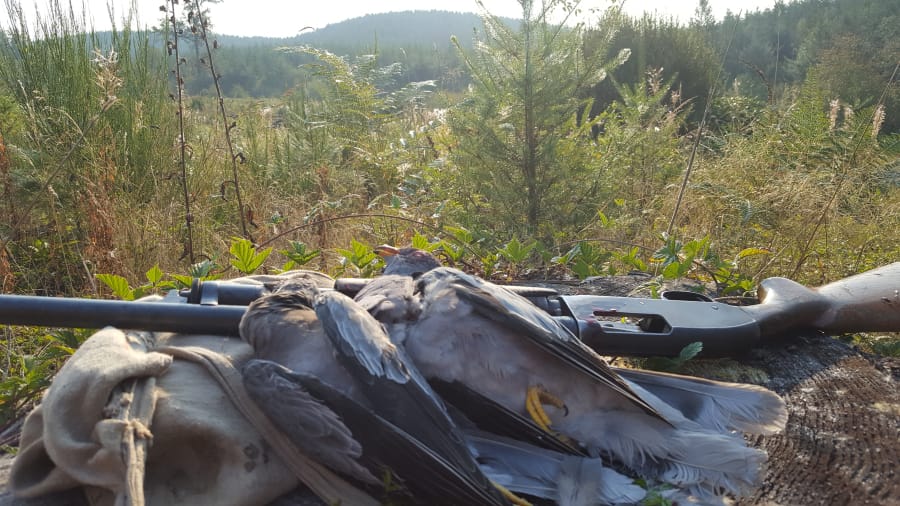As the band-tail pigeon swung in over the gravel pit, I shouldered my Remington Wingmaster shotgun, swung my aim through the bird and fired. It folded and came down hard, and my Lab mix quickly retrieved it. My first shot at a wild pigeon had scored. “Not bad,” I thought to myself, “nothin’ to it!”
I wondered why so many bird hunters had told me that band-tails were a challenging bird to hunt?
I then ran off 21 straight shots without drawing a feather, chewing on humble pie the whole time.
Band-tail pigeons were once much more popular to hunt in the Northwest than they are now. The season was closed in Washington from 1991 to 2001 to let the population recover from over-hunting.
Over that 10 year period most hunters forgot all about them.
These backwoods relatives of the city pigeon are common in the wet forests of the Pacific Northwest. It is a sociable bird that gathers in large flocks as it makes its yearly migrations in the fall and spring.
They are a pastel gray-blue in color, and they can be told from their city-dwelling cousins by the long tail with a wide, pale band at the tip. A white neck crescent is also obvious when the birds are close. They have a black-tipped bill and yellow legs. Their call is a soft, owl-like coo.
And, they fly really fast. Even seasoned scatter-gunners will find them difficult to hit with any regularity.
They are also a wild mountain-loving bird that eats honest, wild foods, and they taste much better than any common pigeon could ever taste.
The band-tailed pigeon is the closest genetic relative of the extinct passenger pigeon. Like the passenger pigeon, band-tails were also hunted hard over the decades, which led to the closures. While the birds are now recovering, they still need protections.
For that reason, the season is short, eight days in total, and the bag limit is two per day. The season runs from Sept. 15-23.
Hunters in Washington will need a small game license, a state migratory bird permit, and a migratory bird authorization with a band-tailed pigeon harvest record card to hunt them.
The band-tails of the Northwest migrate along the Coast and Cascade mountain ranges from British Columbia to California. Hunters ambush them by positioning themselves along saddles that the birds pass over, rock quarries that offer grist for the birds, feeding areas, and mineral springs.
According to Eric Holman, a wildlife biologist with the Washington Department of Fish and Wildlife Region 5, the birds have a fruit and seed diet.
“They are fond of elderberries and cascara berries,” said Holman. “They also like cherries and other fruiting trees.”
“Look for places where they are going for food,” said Holman. “Try pass shooting as they come and go from the feeding areas.”
This heavy diet of fruit in the summer leads the birds to seek out mineral springs to gain extra nutrients. Therefore, mineral springs are great places to hunt for band-tails.
They also tend to sit on the very tips of tall fir trees, especially single trees that give the birds a good view of any approaching threat. Looking for these perched birds is a great way to find the flocks.
Holman reports that hunters take only about 100 to 200 band-tails per year.
“It used to be higher,” he said. “When it reopened in 2002 we would get six to seven hundred a year, but it’s been tapering off.”
He feels the newness of the hunts created some initial excitement when it first reopened, but the extra regulations may be putting some people off.
Either way, the birds are fun to hunt, taste surprisingly good, and offer bird hunting with almost no competition.
These are tough, wild birds, and they are hard to bring down. You had better hit them hard or they will just keep on flying. Forget the game loads, too. Try high-brass loads of shot sizes 5 and 6.
Band-tails have excellent eyesight, and if you raise your gun too early, or let your dog wander, it will spook the incoming birds. Stay well-hidden, and reduce movement if you want any quality shots.
They also have a whole repertoire of dirty tricks. They will sweep over your head from behind, sliding right over you in good range, and they are gone before you can shoot. They will turn on a dime right before they venture into range. And, they can duck and dodge better than a mourning dove.
In Southwest Washington, hunters should look to the tree farms. These actively managed lands tend to draw plenty of birds, but most private timberlands now require a permit to hunt them.
Still, they provide most of what the birds want, and hunters with permits should find them there in good numbers.
Hunters can look for DNR and BLM lands along the migration routes, too. A good pair of binoculars will help you spot the flocks as they move.
If you want a fun wing-shooting challenge, give these birds a try. However, unless you are a better shot than myself, prepare to be humbled.
A word on how to age game birds — Once you have cleaned your game birds place them in a plastic bag and let them refrigerate for two or three days before freezing or cooking. This will tenderize the meat.




